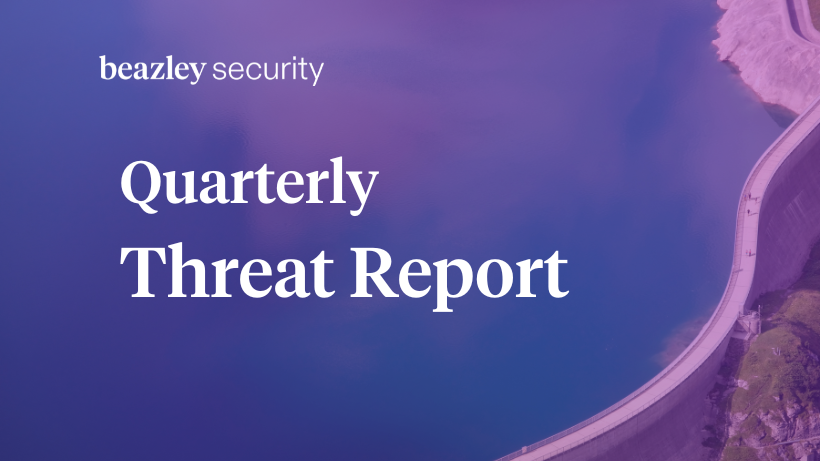Guide to AI Readiness
Artificial intelligence is transforming the way organizations operate, creating new opportunities—and new risks. We cover 5 essential pillars of building a resilient AI strategy that will help you stay ahead.
Artificial intelligence is transforming the business landscape at an unprecedented pace. But with innovation comes complexity and risk. Organizations today face a critical challenge: how to harness AI’s potential while managing its evolving threats and regulatory demands.
In a recent webinar, Dr. Mohibi Hussain, Global Director for Advisory and Microsoft Practices at Beazley Security, and Craig Linton, Head of US Underwriting Management for Cyber Risks at Beazley, shared expert insights on building AI readiness and implementing effective governance frameworks. The message is clear: AI adoption has become a strategic priority.
Why AI unpreparedness is a costly risk
In today’s fast-evolving digital landscape, lack of preparation for AI exposes organizations to serious vulnerabilities. Risks are already present, whether AI is actively used or not. Employees often adopt AI tools like ChatGPT or Copilot without formal approval, creating what’s known as shadow AI. This unsanctioned use can lead to data leaks, compliance violations, and reputational damage.
At the same time, the regulatory environment is intensifying worldwide. In the U.S., over 160 state-level laws now govern AI use, with landmark legislation such as the Colorado AI Act and Texas TRAIGA shaping national standards. Meanwhile, the EU AI Act is shaping the future of global governance, influencing how organizations across borders approach AI compliance. As regulatory frameworks begin to align, businesses must navigate an increasingly complex legal landscape or risk facing significant penalties.
Real-world examples highlight the consequences of poor AI governance:
- iTutor Group paid $365,000 after its AI hiring tool discriminated against older applicants due to algorithmic bias.
- Air Canada’s chatbot mishap made headlines, eroding customer trust.
- McDonald’s AI ordering system was shut down after viral videos revealed embarrassing flaws, resulting in wasted investment and reputational harm.
These incidents demonstrate that AI-related failures can have far-reaching business consequences. Whether you're a user, integrator, or builder of AI, each level of engagement comes with unique risks and governance needs. Even organizations not actively deploying AI are vulnerable to AI-powered threats like deepfakes and phishing.
How to prepare: building a resilient AI strategy
Given the growing risks and regulatory pressures surrounding AI, organizations must shift from reactive concern to proactive readiness. AI is already impacting business operations, the focus now is on how to manage it effectively. Whether you're dealing with shadow AI, integrating third-party tools, or building proprietary models, the foundation of AI preparedness starts with clear strategy, strong governance, and realistic adoption practices.
Organizations should focus on controlled enablement, offering approved tools within secure boundaries, and maintaining visibility over usage. To guide this journey, Dr. Hussain outlined five essential pillars for building AI readiness:
- Clarify AI goals and strategy:
Define clear outcomes and specific strategies to counter AI-related threats.
- Establish a strong data foundation:
Classify data based on sensitivity before allowing AI access.
- Evaluate required technology:
Align your technology stack with your AI strategy and business objectives.
- Empower people and culture:
Conduct risk assessments and provide comprehensive training to foster responsible AI use.
- Implement continuous governance:
Establish ongoing monitoring and improvement processes to adapt as AI evolves.
By starting with these pillars, organizations can build a scalable, secure, and compliant AI strategy, one that balances innovation with control and positions them for long-term success.
Artificial intelligence is transforming the business landscape at an unprecedented pace. But with innovation comes complexity and risk. Organizations today face a critical challenge: how to harness AI’s potential while managing its evolving threats and regulatory demands.
In a recent webinar, Dr. Mohibi Hussain, Global Director for Advisory and Microsoft Practices at Beazley Security, and Craig Linton, Head of US Underwriting Management for Cyber Risks at Beazley, shared expert insights on building AI readiness and implementing effective governance frameworks. The message is clear: AI adoption has become a strategic priority.
Why AI unpreparedness is a costly risk
In today’s fast-evolving digital landscape, lack of preparation for AI exposes organizations to serious vulnerabilities. Risks are already present, whether AI is actively used or not. Employees often adopt AI tools like ChatGPT or Copilot without formal approval, creating what’s known as shadow AI. This unsanctioned use can lead to data leaks, compliance violations, and reputational damage.
At the same time, the regulatory environment is intensifying worldwide. In the U.S., over 160 state-level laws now govern AI use, with landmark legislation such as the Colorado AI Act and Texas TRAIGA shaping national standards. Meanwhile, the EU AI Act is shaping the future of global governance, influencing how organizations across borders approach AI compliance. As regulatory frameworks begin to align, businesses must navigate an increasingly complex legal landscape or risk facing significant penalties.
Real-world examples highlight the consequences of poor AI governance:
- iTutor Group paid $365,000 after its AI hiring tool discriminated against older applicants due to algorithmic bias.
- Air Canada’s chatbot mishap made headlines, eroding customer trust.
- McDonald’s AI ordering system was shut down after viral videos revealed embarrassing flaws, resulting in wasted investment and reputational harm.
These incidents demonstrate that AI-related failures can have far-reaching business consequences. Whether you're a user, integrator, or builder of AI, each level of engagement comes with unique risks and governance needs. Even organizations not actively deploying AI are vulnerable to AI-powered threats like deepfakes and phishing.
How to prepare: building a resilient AI strategy
Given the growing risks and regulatory pressures surrounding AI, organizations must shift from reactive concern to proactive readiness. AI is already impacting business operations, the focus now is on how to manage it effectively. Whether you're dealing with shadow AI, integrating third-party tools, or building proprietary models, the foundation of AI preparedness starts with clear strategy, strong governance, and realistic adoption practices.
Organizations should focus on controlled enablement, offering approved tools within secure boundaries, and maintaining visibility over usage. To guide this journey, Dr. Hussain outlined five essential pillars for building AI readiness:
- Clarify AI goals and strategy:
Define clear outcomes and specific strategies to counter AI-related threats.
- Establish a strong data foundation:
Classify data based on sensitivity before allowing AI access.
- Evaluate required technology:
Align your technology stack with your AI strategy and business objectives.
- Empower people and culture:
Conduct risk assessments and provide comprehensive training to foster responsible AI use.
- Implement continuous governance:
Establish ongoing monitoring and improvement processes to adapt as AI evolves.
By starting with these pillars, organizations can build a scalable, secure, and compliant AI strategy, one that balances innovation with control and positions them for long-term success.
Learn more
.jpg)
For more on the critical cybersecurity controls you should be using and how they can protect your organization, replay the webinar on demand at:
Top Threats for 2025 (Webinar Replay)
More Insights
View All >Beazley Security can help protect you
We offer services and solutions to help you prepare and stay resilient in the changing threat landscape. Prepare to learn more about how we can help you









